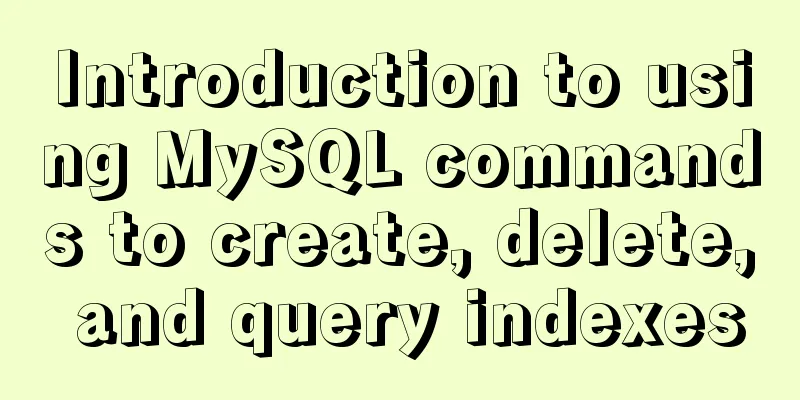Getting Started Guide to MySQL Sharding

PrefaceRelational databases are more likely to become system bottlenecks. The storage capacity, number of connections, and processing power of a single machine are limited. When the amount of data and concurrency increase, the database must be segmented. The means of data sharding is to divide the database and table into different parts. There are two aspects to sharding libraries and tables. It may be sharding libraries only without sharding tables, or sharding tables only without sharding libraries. The core content of database distribution is nothing more than data segmentation, as well as the positioning and integration of data after segmentation. Why do we need to divide the database into different tables?Sub-table When the amount of data in a single table is too large, it will seriously affect the performance of SQL execution. Generally, when a single table reaches several million, the performance will be relatively poor, and then it is necessary to divide the table into sub-tables. Splitting tables means putting the data of one table into multiple tables, and then querying only one table. For example, divide the table by project ID: put a fixed number of project data in one table, so that the amount of data in each table can be controlled within a controllable range. Sub-library According to experience, a database needs to be expanded when it supports a maximum of 2000 concurrent requests, and the concurrency value of a healthy single database is best maintained at around 1000. Then you can split the data of one library into multiple libraries, and only need to access one library when accessing. This is what is called sharding the database and tables. Why do we need to shard the database and tables?
How to divide the database and tableDirectly look at the picture:
For vertical splitting, it is recommended to design the table well at the beginning of system design to avoid vertical splitting of the table. Horizontal splitting can be done by range or by a certain field hash. The advantage of dividing by range is that capacity expansion is simple, and you only need to prepare a new table or database. However, it is easy to cause hot issues, so it should be considered in combination with business scenarios when actually used. The advantage of dividing by hash is that the request pressure of each database or table can be evenly distributed. The disadvantage is that capacity expansion is difficult, and the previous data needs to be rehashed, which involves a data migration process. Problems caused by shardingSub-database and sub-table can effectively alleviate the pressure on network IO, hardware resources, and number of connections brought by a single machine and a single database. But it also brought some problems.
Data MigrationTwo data migration solutions are introduced. The lowest-level solution is to shut down the system for a while, use a pre-written data import tool to extract the data from a single table, and write it to the sub-library and sub-table. The second solution sounds more reliable, the dual-write migration solution. In the online system, all the places where data was previously written, the addition, deletion and modification operations, in addition to the addition, deletion and modification of the old database, are added to the addition, deletion and modification of the new database. This is the so-called double write. After the system is deployed, run the data import tool in Solution 1 to read the old database and write the new database. When writing, the last modification time of the data should be determined based on fields such as gmt_modified. The data will only be written if the new database does not have the data or the data is newer than the new database data. Simply put, it is not allowed to overwrite new data with old data. After one round of writing, there may still be inconsistencies. In this case, the program will automatically perform a new round of verification, comparing each piece of data in each table of the new and old databases. If there are any differences, the program will read the data from the old database and write it again. Repeat the cycle until the data is completely consistent. middlewareThe more common middleware for sub-library and sub-table are:
In summary, Sharding-jdbc and Mycat are the options that can be considered. The advantages of the client-layer solution such as Sharding-jdbc are that it does not require deployment, has low operation and maintenance costs, does not require secondary forwarding at the proxy layer, and has high performance. The disadvantage is coupling. MySQL partitioning (deprecated) Partitioning is introduced here mainly to avoid confusion with concepts such as splitting, database and table sharding, etc.
Here is an example of a LIST partition: CREATE TABLE orders_list ( id INT AUTO_INCREMENT, customer_surname VARCHAR(30), store_id INT, salesperson_id INT, order_date DATE, note VARCHAR(500), INDEX idx (id) ) ENGINE = INNODB PARTITION BY LIST(store_id) ( PARTITION p1 VALUES IN (1, 3, 4, 17) INDEX DIRECTORY = '/var/orders/district1' DATA DIRECTORY = '/var/orders/district1', PARTITION p2 VALUES IN (2, 12, 14) INDEX DIRECTORY = '/var/orders/district2' DATA DIRECTORY = '/var/orders/district2', PARTITION p3 VALUES IN (6, 8, 20) INDEX DIRECTORY = '/var/orders/district3' DATA DIRECTORY = '/var/orders/district3', PARTITION p4 VALUES IN (5, 7, 9, 11, 16) INDEX DIRECTORY = '/var/orders/district4' DATA DIRECTORY = '/var/orders/district4', PARTITION p5 VALUES IN (10, 13, 15, 18) INDEX DIRECTORY = '/var/orders/district5' DATA DIRECTORY = '/var/orders/district5' ); Advantages of partitioning:
SummarizeThis is the end of this article about MySQL sharding. For more information about MySQL sharding, please search for previous articles on 123WORDPRESS.COM or continue to browse the following related articles. I hope you will support 123WORDPRESS.COM in the future! You may also be interested in:
|
<<: Zen coding for editplus example code description
>>: js implements custom drop-down box
Recommend
MYSQL METADATA LOCK (MDL LOCK) theory and lock type test
Table of contents MYSQL METADATA LOCK (MDL LOCK) ...
A brief discussion on HTML special character encoding CSS3 content: "I am a special symbol"
Some special characters and icons used in the pro...
Implementation of clicking through the transparent area of irregular forms in Electron
Table of contents Implementing an irregular form ...
Example of Form action and onSubmit
First: action is an attribute of form. HTML5 has d...
Getting Started with Website Building for Beginners - The Conditions and Tools Needed to Build a Website
Today, I will answer these newbie questions: Build...
MySQL tutorial on how to deploy multiple instances on a single machine using mysqld_multi
Table of contents 1. MySQL compilation and instal...
Vue uses canvas handwriting input to recognize Chinese
Effect picture: Preface: Recently, I was working ...
More than 300 lines of CSS code to achieve the explosive special effects of WeChat 8.0
A major feature of the WeChat 8.0 update is the s...
Mini Program implements list countdown function
This article example shares the specific code for...
Detailed explanation of the idea of achieving the point-earning effect with CSS animation
In the recent project, we need to create an effec...
JavaScript programming through Matlab centroid algorithm positioning learning
Table of contents Matlab Centroid Algorithm As a ...
Why does MySQL paging become slower and slower when using limit?
Table of contents 1. Test experiment 2. Performan...
Summary of important mysql log files
Author: Ding Yi Source: https://chengxuzhixin.com...
Node.js+express message board function implementation example
Table of contents Message Board Required librarie...
HTML form and the use of form internal tags
Copy code The code is as follows: <html> &l...










